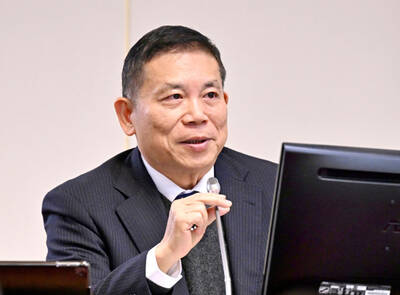At the height of cryptocurrency’s COVID-19-pandemic boom, migrant worker Gian Carlo McGlay thought he had found a way to ride out lockdowns and provide an income to dozens of jobless people from his hometown in the Philippines.
However, McGlay’s dreams of leading a team of “play-to-earn” cryptocurrency gamers focused on the Axie Infinity game quickly fell apart as crypto prices crashed, leaving the 32-year-old with losses of 1 million Philippine pesos (US$18,031).
“Nothing was left. My Axie Infinity assets became worthless, so I just gave them away,” McGlay said.

Photo: AFP
One of a new breed of blockchain-based online games that blend entertainment with financial speculation, Axie Infinity also attracted investors who saw it as a way to introduce more people to cryptocurrency.
Axie players can earn cryptocurrency by cashing in tokens they win in the game — called smooth love potion (SLP). For a while, it was a lucrative business.
McGlay’s “scholars” — a term used for players who cannot afford to buy the game’s characters themselves so instead rent them off so-called managers in exchange for a cut of their earnings — initially earned 5,000 to 10,000 pesos per week.
In contrast to other Axie managers, McGlay — who worked as a fisher in Alaska before the pandemic — said he made no profit from the enterprise, letting his scholars keep all of their earnings.
At its peak, Axie Infinity drew 2.7 million active daily users, but those numbers have plunged to about 250,000, according to Cryptogambling.tv, a Web site focused on cryptocurrency games.
Half of the game’s players came from the Philippines — and many others from developing countries such as Brazil, Indonesia, Peru and Venezuela.
Yield Guild Games (YGG), a group that invests in non-fungible token (NFT) games, said it “prioritized providing scholarships in emerging economies where job opportunities are lacking and government relief has been limited” during the pandemic.
Many managers like McGlay were left facing big losses as the value of the game’s SLP tokens fell 99 percent from its peak in February last year, mirroring a collapse in the price of cryptocurrencies.
Axie Infinity was dealt another blow the following month, when hackers stole about US$615 million in cryptocurrency from a blockchain network that lets users transfer crypto in and out of the game.
While some Axie managers say their motives were philanthropic, other small investors were motivated by the potential gains.
Christopher Cruz, 36, a Filipino businessman and cryptocurrency trader who used to manage 200 Axie scholars, said he earned as much as 600,000 pesos a day from the game by taking a 60 percent cut of his players’ income.
“I felt like a drug lord,” Cruz said. “I could buy everything I wanted — every item inside the mall was never too expensive — during that time.”
His scholars, who were mostly high-school students and gig workers from poor provinces, earned a daily income of 450 pesos, just below the minimum wage of 470 pesos in regions outside the capital, Manila.
A Filipino doctor, who asked not to be named, said it was “extremely easy” to recruit players during the pandemic and that her earnings as a manager were similar to her income from her regular job.
SLP tokens were worth 3 pesos each when McGlay, Cruz and the doctor joined the game. The token’s value peaked at 20 pesos, before plunging steadily in late 2021. It now stands at about 0.16 pesos.
“It’s no longer worth it. The gameplay also became more difficult,” Cruz said, adding that it was now difficult to earn 50 SLP per day — down from 150 in its heyday.
Losing their new income source, legions of scholars abandoned the game, turning to gig work as delivery riders or online clothes seller or taking up full-time education.
“The players who were motivated purely by the financial rewards of the game have moved on to other things now,” YGG Philippines manager Luis Buenaventura said.
YGG continues to rent out Axie’s NFT characters to interested players, “but it’s not as necessary as it once was since those NFTs are all really affordable now,” he said.
Axie’s dizzying ups and downs should serve as a warning sign to potential investors in the volatile crypto world, said Elaine Tinio, a marketing professional in Manila who used to play the game for up to four hours a day to boost her income.
Thrilled by her initial profits, she spent more and more money on Axie characters before a sharp decline in the value of the game’s SLP token left her facing a loss of 200,000 pesos, equivalent to about five months of her salary.
“Greed got the best of us,” she said.

UNCERTAINTY: Innolux activated a stringent supply chain management mechanism, as it did during the COVID-19 pandemic, to ensure optimal inventory levels for customers Flat-panel display makers AUO Corp (友達) and Innolux Corp (群創) yesterday said that about 12 to 20 percent of their display business is at risk of potential US tariffs and that they would relocate production or shipment destinations to mitigate the levies’ effects. US tariffs would have a direct impact of US$200 million on AUO’s revenue, company chairman Paul Peng (彭雙浪) told reporters on the sidelines of the Touch Taiwan trade show in Taipei yesterday. That would make up about 12 percent of the company’s overall revenue. To cope with the tariff uncertainty, AUO plans to allocate its production to manufacturing facilities in

Taiwan will prioritize the development of silicon photonics by taking advantage of its strength in the semiconductor industry to build another shield to protect the local economy, National Development Council (NDC) Minister Paul Liu (劉鏡清) said yesterday. Speaking at a meeting of the legislature’s Economics Committee, Liu said Taiwan already has the artificial intelligence (AI) industry as a shield, after the semiconductor industry, to safeguard the country, and is looking at new unique fields to build more economic shields. While Taiwan will further strengthen its existing shields, over the longer term, the country is determined to focus on such potential segments as

TAKING STOCK: A Taiwanese cookware firm in Vietnam urged customers to assess inventory or place orders early so shipments can reach the US while tariffs are paused Taiwanese businesses in Vietnam are exploring alternatives after the White House imposed a 46 percent import duty on Vietnamese goods, following US President Donald Trump’s announcement of “reciprocal” tariffs on the US’ trading partners. Lo Shih-liang (羅世良), chairman of Brico Industry Co (裕茂工業), a Taiwanese company that manufactures cast iron cookware and stove components in Vietnam, said that more than 40 percent of his business was tied to the US market, describing the constant US policy shifts as an emotional roller coaster. “I work during the day and stay up all night watching the news. I’ve been following US news until 3am

COLLABORATION: Given Taiwan’s key position in global supply chains, the US firm is discussing strategies with local partners and clients to deal with global uncertainties Advanced Micro Devices Inc (AMD) yesterday said it is meeting with local ecosystem partners, including Taiwan Semiconductor Manufacturing Co (TSMC, 台積電), to discuss strategies, including long-term manufacturing, to navigate uncertainties such as US tariffs, as Taiwan occupies an important position in global supply chains. AMD chief executive officer Lisa Su (蘇姿丰) told reporters that Taiwan is an important part of the chip designer’s ecosystem and she is discussing with partners and customers in Taiwan to forge strong collaborations on different areas during this critical period. AMD has just become the first artificial-intelligence (AI) server chip customer of TSMC to utilize its advanced